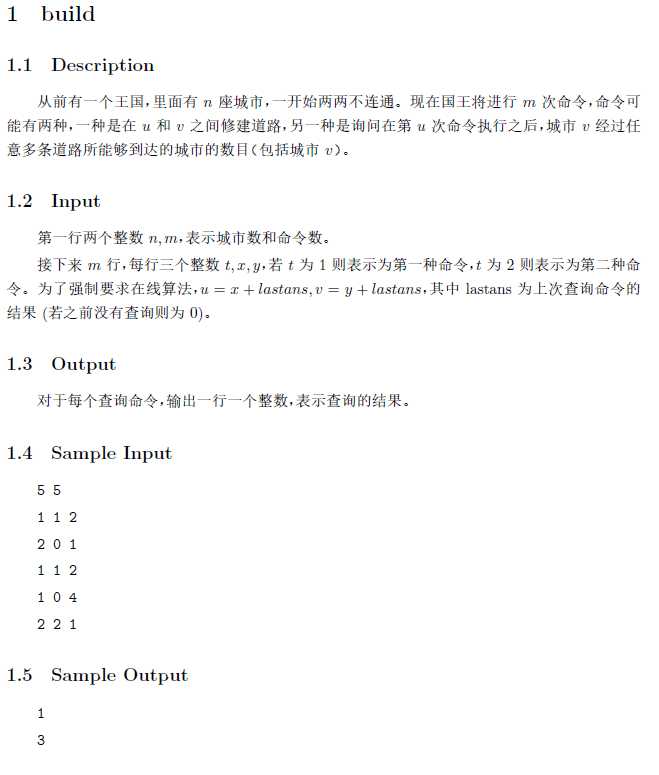标签:联通 技术分享 build tin dig 输出 print ble tps
int fa[maxn];
int find(int x) {
return fa[x]==x?x:fa[x]=find(fa[x]);
}
void un(int x,int y) {
fa[find(x)]=find(y);
}int fa[maxn],siz[maxn];
int find(int x) {
return fa[x]==x?x:find(fa[x]);
}
void un(int x,int y) {
if(siz[x=find(x)]>siz[y=find(y)])
fa[x]=y,siz[y]+=siz[x];
else fa[y]=x,siz[x]+=siz[y];
}可以算联通块,也可以按秩合并+路径压缩
联通了,就并到一起,siz加起来,如果siz=n,就直接输出时间即可。
10min切。
代码:
#include<bits/stdc++.h>
const int maxn=1000+5;
const int maxm=1e5+5;
int fa[maxn],siz[maxn];
struct Edge {
int x,y,t;
}e[maxm];
int find(int x) {
return fa[x]==x?x:fa[x]=find(fa[x]);
}
void un(int x,int y) {
if(x==y) return ;
fa[x]=y;
siz[y]+=siz[x];
}
bool cmp(const Edge &a,const Edge &b) {
return a.t<b.t;
}
int main() {
int n,m;scanf("%d%d",&n,&m);
for(int i=1;i<=n;i++) fa[i]=i,siz[i]=1;
for(int i=1;i<=m;i++)
scanf("%d%d%d",&e[i].x,&e[i].y,&e[i].t);
std::sort(e+1,e+m+1,cmp);
for(int i=1;i<=m;i++) {
int xx=find(e[i].x),yy=find(e[i].y);
un(xx,yy);
if(siz[yy]==n) return !printf("%d",e[i].t);
}
printf("-1");
return 0;
}很长时间里,我以为这就是并查集的全部内容了。
直到:
也许叫这个名字,我也不清楚。
并查集可以很好表示亲戚的亲戚是亲戚这种关系,但是对于敌人的敌人是朋友这种情况就显得无能为力。
使用两倍的并查集,i表示相同,i+n表示相对,于是就有了相对的相对是相同的关系。
我的猎物的猎物是我的天敌。(真的违反自然规律好吧)
于是开三倍大小的并查集,i表示同类,i+n表示猎物,i+n+n表示天敌。
于是就解决了。
#include<bits/stdc++.h>
const int maxn=5e4+5;
int fa[maxn*3];
int find(int x) {
return x==fa[x]?x:fa[x]=find(fa[x]);
}
int main() {
int n,k;scanf("%d%d",&n,&k);
for(int i=1;i<=n*3;i++) fa[i]=i;
int ans=0;
while(k--) {
int opt,x,y;scanf("%d%d%d",&opt,&x,&y);
if(x>n || y>n) {++ans;continue;}
if(opt==1) {
if(find(x)==find(y+n) || find(y)==find(x+n)) ++ans;
else for(int i=0;i<3;i++) fa[find(x+i*n)]=find(y+i*n);
}
else {
if(find(x)==find(y) || find(x)==find(y+n)) ++ans;
else for(int i=0;i<3;i++) fa[find(x+(i+1)%3*n)]=find(y+i*n);
}
}
printf("%d",ans);
return 0;
}要建图,先全部毁于一旦,在从后往前时光倒流,做法跟修复公路计算连通块又异曲同工之妙。
#include<cstdio>
#include<cstring>
#include<iostream>
#include<algorithm>
const int maxn=1e6+5;
struct Edge {
int nxt,v,frm;
}e[maxn];
int h[maxn],tot;
void add_edge(int u,int v) {
e[++tot].v=v;
e[tot].nxt=h[u];
h[u]=tot;
e[tot].frm=u;
}
int fa[maxn];
int find(int x) {
return fa[x]==x?x:fa[x]=find(fa[x]);
}
int z[maxn];
bool vis[maxn];
int ans[maxn];
int main() {
int n,m;scanf("%d%d",&n,&m);
for(int i=0;i<n;i++) fa[i]=i,h[i]=-1;
for(int i=0;i<m;i++) {
int x,y;scanf("%d%d",&x,&y);
add_edge(x,y);
add_edge(y,x);
}
int k;scanf("%d",&k);
int cnt=n-k;
for(int i=1;i<=k;i++) {
scanf("%d",z+i);
vis[z[i]]=true;
}
for(int i=0;i<m+m;i++) {
if((!vis[e[i].frm]) && (!vis[e[i].v]) && (find(e[i].frm)!=find(e[i].v)))
fa[find(e[i].frm)]=find(e[i].v),--cnt;
}
ans[k+1]=cnt;
for(int t=k;t>0;t--) {
vis[z[t]]=false;
++cnt;
for(int i=h[z[t]];~i;i=e[i].nxt) {
if((!vis[e[i].v]) && (find(e[i].v)!=find(z[t])))
fa[find(e[i].v)]=find(z[t]),--cnt;
}
ans[t]=cnt;
}
for(int i=1;i<=k+1;i++) printf("%d\n",ans[i]);
return 0;
}掌握了这几道,感觉基本可以说是较全面的掌握了并查集。
(其实只是过了试练场罢了)


我博客里有写。
再贴一遍代码
#include<bits/stdc++.h>
#define FN "build"
const int maxn=1e5+5;
inline int read() {
int x;char ch;bool flag=false;while(!isdigit(ch=getchar()))
(ch==‘-‘) && (flag=true);
for(x=ch-‘0‘;isdigit(ch=getchar());x=(x<<3)+(x<<1)+ch-‘0‘);
return (flag?-x:x);
}
namespace HJT {
int n;
struct Node {
Node *ls,*rs;
int siz,fa;
}pool[maxn*32], *root[maxn], *zero, *tail=pool;
Node *newnode() {
Node *nd=++tail;
nd->ls=nd->rs=zero;
nd->siz=nd->fa=0;
return nd;
}
Node *Fmodify(Node *p,int l,int r,int pos,int rt) {
Node *nd=newnode();
if(l==r) {
nd->fa=rt;
nd->siz=p->siz;
return nd;
}
int mid=l+r>>1;
if(pos<=mid) {
nd->rs=p->rs;
nd->ls=Fmodify(p->ls,l,mid,pos,rt);
}
else {
nd->ls=p->ls;
nd->rs=Fmodify(p->rs,mid+1,r,pos,rt);
}
return nd;
}
Node *Smodify(Node *p,int l,int r,int pos,int rt) {
Node *nd=newnode();
if(l==r) {
nd->fa=p->fa;
nd->siz=p->siz+rt;
return nd;
}
int mid=l+r>>1;
if(pos<=mid) {
nd->rs=p->rs;
nd->ls=Smodify(p->ls,l,mid,pos,rt);
}
else {
nd->ls=p->ls;
nd->rs=Smodify(p->rs,mid+1,r,pos,rt);
}
return nd;
}
int Fquery(Node *nd,int l,int r,int pos) {
if(l==r) return nd->fa;
int mid=l+r>>1;
if(pos<=mid) return Fquery(nd->ls,l,mid,pos);
else return Fquery(nd->rs,mid+1,r,pos);
}
int Squery(Node *nd,int l,int r,int pos) {
if(l==r) return nd->siz;
int mid=l+r>>1;
if(pos<=mid) return Squery(nd->ls,l,mid,pos);
else return Squery(nd->rs,mid+1,r,pos);
}
int find(int i,Node *nd,int x) {
int ff=Fquery(nd,1,n,x);
if(ff==x) return x;
return find(i,nd,ff);
}
Node *build(int l,int r) {
Node *nd=newnode();
if(l==r) {
nd->siz=1;
nd->fa=l;
return nd;
}
int mid=l+r>>1;
nd->ls=build(l,mid);
nd->rs=build(mid+1,r);
return nd;
}
void work() {
int m=read();n=read();
int lastans=0,tot=0;
zero=++tail;
zero->ls=zero->rs=zero;
zero->fa=zero->siz=0;
root[0]=build(1,n);
for(int i=1;i<=m;i++) {
int opt=read();
int u=lastans+read();
int v=lastans+read();
if(opt==1) {
u=find(tot,root[tot],u);
v=find(tot,root[tot],v);
if(u==v) {
++tot;
root[tot]=root[tot-1];
continue;
}
int siz1=Squery(root[tot],1,n,v);
int siz2=Squery(root[tot],1,n,u);
if(siz1>siz2) {
std::swap(siz1,siz2);
std::swap(u,v);
}
++tot;
root[tot]=Fmodify(root[tot-1],1,n,v,u);
root[tot]=Smodify(root[tot],1,n,u,siz1);
}
else {
int ff=find(u,root[u],v);
int siz1=Squery(root[u],1,n,ff);
root[tot+1]=root[tot];
++tot;
lastans=siz1;
printf("%d\n",siz1);
}
}
}
}
int main(){
freopen(FN".in","r",stdin);
freopen(FN".out","w",stdout);
HJT::work();
return 0;
}可持久化并查集真的不知道还算不算并查集,真的区别太大了。
标签:联通 技术分享 build tin dig 输出 print ble tps
原文地址:https://www.cnblogs.com/LoLiK/p/9739820.html